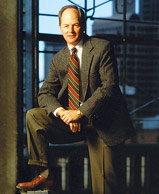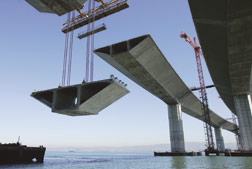You have to admire the tenacity of surety bond underwriters. Through four years of industry losses—pinned on them by overstretched or incompetent contractors—sureties have observed an iron discipline in order to return to profitability. They have refused to bond contractors that failed to meet rigid financial standards, increased the scope of their analysis and cut their concentrations of risk with individual companies and projects. The sureties also shaved their own costs.
In 2005, the surety industry was rewarded for its faith and saw a modest, industry-wide profit. In 2006, the profit was substantial, with the loss ratio for the year flirting with 20%, well below the 35% to 40% loss ratio needed by many firms to profit, and a world of improvement over the disaster year of 2004, when the loss ratio topped 70%.
 WebCor |
"When Webcor won a complex project, its surety would say, 'Oh no!' " — Andy Ball,
Chief Executive, Webcor Builders |
And what thanks do the sureties get? Listen to Andy Ball, the chief executive of Webcor Builders, the big San Mateo, Calif.-based building contractor: “We would tell [our] surety] that we had just won a big, multiyear project and the surety would say, ‘Oh no!’ But that’s what we do, we win big complex projects and we don’t want to hear, ‘Oh no!’" Partly to avoid the limits on its surety credit and replace bonds with a guarantee from a big parent company, Webcor is selling 70% of itself to Japan’s Obayashi Corp.
‘Oh no!’ may be the surety bond underwriters’ battle cry for years to come, if they can resist competitive pressure and temptation to loosen up again now that times are better. In general, the tough fundamental tactic will continue, surety executives, brokers and contractors say, especially with the still-fresh memories of some recent company wipeouts like Modern Continental and J.A. Jones. That makes it likely that the changes triggered by the tighter underwriting, especially in public works, will continue.
In some eyes, the tight surety standards have pared the number of eligible competitors for public works projects. That partly explains the higher number of projects for which only a single bid is submitted. There appears to be fewer firms that can qualify for a $75-million bond on a single project even though the public works market is strong, says John Saliba, vice president of public works contractor and engineer FTR International Inc., Irvine, Calif. “Why else are there not more bids on the larger projects? It’s definitely a sureties market now,” he says.
According to Saliba, sureties “are making more money than ever, as there are fewer contractor defaults, [and] the surety can be extra-selective as to who they admit and which projects, and agencies they’ll bond.” He notes that “it takes many years of successful contracting to ‘climb the surety ladder’ and at this point in time, it seems as though the largest general contractors pick and choose the projects that best suit their needs.”
Others say contractors are having the capacity problems, not sureties. “They have so much work out there,” says Steve Wulff, bond manager for Eustis Insurance and Benefits, a broker in New Orleans.
Left out of the party are smaller, less well-capitalized specialty and subcontractors that can’t qualify for bonds. But for many contractors, times have never been better and the sureties will not likely change their practices much until more years of profit have been put in the books, say surety executives.
| Top Sureties* | Premium ($mil) |
| Travelers Bond (St. Paul Travelers) | |
| CNA Insurance Group | |
| Zurich Insurance Group | |
| Safeco Insurance Group | |
| Chubb & Son Inc. | |
| Liberty Mutual Insurance Group | |
| Hartford Fire & Casualty | |
Source: Surety & Fidelity Association of America. Additional data is available at surety.org. | |
Contract surety, the majority of surety business, was always a small world with roots that go back to antiquity but with modern origins in a 1908 law adopted by Congress. The big boost for surety came in 1935 with the Great Depression-era Miller Act. Numerous states have their own version. It requires sureties’ unique three-party contractor-owner-surety guarantees for the bid, project completion and payments. A surety bond is not an insurance policy because the surety does not plan and expect a certain number of claims and must pay to finish the contractor’s obligation if the owner properly terminates the contractor. Then, the surety tries to get its money back from the contractor.
Today surety of all kinds is only a $4.5-billion annual business. Consolidation and financial demise have shrunk the players from about 15 major national underwriters 10 years ago to about seven now. From 1980 to 1990, there was no consolidation or exit from the market by top sureties. During the next 15 years, 10 of the top 15 sureties either dropped out or consolidated.
The losses that piled up helped thin out the underwriters, but so did consolidation among insurers and financial services firms culminating in the 2004 merger that created the colossus St. Paul Travelers. Travelers merged with Reliance Surety in 2000, but various prior mergers or acquisitions had brought USF&G Group, Aetna Life & Casualty Group and Seaboard Surety Co. into the combined operations.
 |
According to the Surety & Fidelity Association of America, Travelers Bond wrote surety premiums of all kinds totalling about $885 million in 2005, most of it contract surety. Some sources claim this represents as much as one out of every four dollars of major bonded construction projects. Travelers points out that its big national accounts represent only 23% of its written premium.
Is this consolidation a problem? Only if that company or one of the other big sureties involved in co-surety pacts for big projects decides to shrink its book of business by 10% or 20%. That could throw the world of big public works into another period of wrenching adjustments like the ones that started around 2001, some say. “That would be catastrophic,” claims one broker concerned that the next tier of sureties may not be able to pick up all that business. “To the extent that any one of the Big Three had a change in appetite, that market for $1-billion projects would really have a pretty significant level of pain.”
Don’t worry, others say. Travelers Bond Construction Services says in a statement that it and other sureties that support large accounts and projects have enough capacity and Travelers says it expects “to experience profitable growth again in 2007” in its big, middle and small firm markets.
“The capacity is there,” says Lynn Schubert, president of the Surety & Fidelity Association of America. “All you hear is constriction, constriction, constriction, but what projects haven’t gone forward or haven’t we come up with the surety for?” Other sources echo her reassurance.
To fill any gaps, Chubb has recently launched a new excess surety product, a kind of hybrid. It has not yet found a customer, according to the company.
 AP Sureties limited their risk concentration and declined to provide credit for the full value of the new Oakland-San Francisco Bay Bridge.
|
In cutting concentration of risk, the sureties have refused to bond the full value of megaprojects, those above $750 million, such as the massive new Oakland-San Francisco Bay Bridge, which required special permission from California lawmakers to proceed without full-penalty bonds. Large public-private partnerships and the billion-dollar projects they involve are hard to cover. “Everyone’s trying to figure out how to meet the needs of this model,” says one big broker. Some industry sources say they see single-project surety credit limits of up to $800 million. Others say $250 million to $300 million is closer to the top.
Public works agencies no longer expect full-value surety protection. “The owners are having to shift their approach and understand the restrictions of what the market will bear,” says Frank Finlayson, senior vice president of project development for Washington Group International, Boise. “Given the market shift, [transportation agencies] have had to change their practices based on what’s available.” The owners cover themselves by making sure that payments never get ahead of completed work. That, in combination with the bonds, still leaves them, “amply protected on these megaprojects,” says Finlayson.
Pacts.
Sureties also have refused to take risks alone, teaming up in the time-consuming co-surety pacts that now are standard on big jobs. Travelers Bond, Zurich and Chubb team as co-sureties on most of the major megaprojects, industry sources say, making compacts that require the companies to look at each other’s risk portfolio. “It’s six times as labor intensive,” says one source.
This closeness may have bred a cohesive attitude in dealing with owners. In addition to requiring owners to accept the less-than-full penalty bonds—a situation that happens on several dozen very big projects each year—the sureties have been able to get owners to take back risks that contractors by themselves were unable to fend off. The most worrisome kinds involve long warranties that could come back to bite the sureties years after the keys are turned over to the owner.
Getting owners to back away on something like that “is a wonderful service to the industry,” says Hugh Rice, chairman of management and financial consultant FMI Corp., Denver.
The new alertness to contract risk is signified by Zurich North America Surety, which opened a risk management department and put a vice president in charge who is a construction attorney with claims experience. “Our customers love it,” says William E. Cheatham, president. One out of three of Zurich’s losses over the past few...

